Tertiary education
The examples and perspective in this articlemay not represent aworldwide viewof the subject.(April 2018) |


Tertiary education,also referred to asthird-level,third-stageorpost-secondary education,is theeducationallevel following the completion ofsecondary education.TheWorld Bank,for example, defines tertiary education as includinguniversitiesas well astrade schoolsandcolleges.[1]Higher educationis taken to includeundergraduateandpostgraduate education,whilevocational educationbeyond secondary education is known asfurther educationin theUnited Kingdom,or included under the category ofcontinuing educationin theUnited States.
Tertiary education generally culminates in the receipt ofcertificates,diplomas,oracademic degrees.Higher education represents levels 5, 6, 7, and 8 of the2011 versionof theInternational Standard Classification of Educationstructure. Tertiary education at a nondegree level is sometimes referred to asfurther educationorcontinuing educationas distinct from higher education.
UNESCOstated that tertiary education focuses on learning endeavors in specialized fields. It includes academic and higher vocational education.[2]
TheWorld Bank's 2019World Development Reporton the future of work[3]argues that given the future of work and the increasing role of technology in value chains, tertiary education becomes even more relevant for workers to compete in the labor market.
Definition[edit]

Higher education, also called post-secondary education, third-level ortertiary education,is an optional final stage offormal learningthat occurs after completion ofsecondary education.This consists ofuniversities,collegesandpolytechnicsthat offer formal degrees beyond high school or secondary school education.
TheInternational Standard Classification of Educationin 1997 initially classified all tertiary education together in the1997 versionof its schema. They were referred to as level 5 and doctoral studies at level 6. In 2011, this was refined and expanded in the2011 versionof the structure. Higher education at undergraduate level, masters and doctoral level became levels 6, 7, and 8. Nondegree leveltertiary education,sometimes referred to asfurther educationorcontinuing educationwas reordered as level 4, with level 5 for some higher courses.[4]
In the days when few pupils progressed beyondprimary educationorbasic education,the term "higher education" was often used to refer to secondary education, which can create some confusion.[note 1]This is the origin of the termhigh schoolfor various schools for children between the ages of 14 and 18 (United States) or 11 and 18 (United Kingdom and Australia).[5]
Global progress[edit]
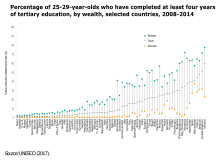
Globally, the gross enrollment ratio in tertiaryeducationincreased from 19% in 2000 to 38% in 2017, with thefemaleenrollment ratio exceeding the male ratio by 4 percentage points.[6]
The tertiary gross enrollment ratio ranges from 9% inlow-income countriesto 77% inhigh-income countries,where, after rapid growth in the 2000s, reached a plateau in the 2010s.[6]
Between now and 2030, the biggest increase in tertiary enrollment ratios is expected in middle-income countries, where it will reach 52%.Sustainable Development Goal 4(SDG 4) commits countries to providinglifelong learningopportunities for all, including tertiary education.[6]
This commitment is monitored through the global indicator for target 4.3 in the sustainable development goal 4 (SDG 4), which measures the participation rate ofyouthandadultsin formal and non-formal education and training in the previous 12 months, whether for work or non-work purposes.[6]
The right of access to higher education[edit]
The right of access to higher education is mentioned in a number ofinternational human rights instruments.The UNInternational Covenant on Economic, Social and Cultural Rightsof 1966 declares, in Article 13, that "higher education shall be made equally accessible to all, on the basis of capacity, by every appropriate means, and in particular by the progressive introduction of free education".[7]InEurope,Article 2 of theFirst Protocol to the European Convention on Human Rights,adopted in 1950, obliges all signatory parties to guarantee theright to education.[8]
Criticism[edit]
In 1994, the UNESCO Salamanca Statement called on the international community to endorse the approach of inclusive education, including at the tertiary level. Since this time the world has witnessed the global massification of tertiary education, yet this explosion of facilities and enrollment has largely entrenched and exacerbated the exclusion of people with disabilities. This is particularly the case in low- and middle-income contexts, where university completion rates for students with disabilities are much lower compared to completion rates of students without disabilities.[9]
Some tertiary schools have been criticized as having permitted or actively encouragedgrade inflation.[10][11]In addition, certain scholars contend that the supply of graduates in some fields of study is exceeding the demand for their skills, aggravatinggraduate unemployment,underemploymentandcredentialism.[12][13]
Influence on views[edit]
Graduates of tertiary education are likely to have different worldviews and moral values than non-graduates. Research indicates that graduates are more likely to havelibertarianprinciples with less adherence to social hierarchies. Graduates are also more likely to embrace cultural and ethnic diversity and express more positive views towards minority groups. For international relationships, graduates are more likely to favor openness, supporting policies likefree trade,open borders,theEuropean Union,and more liberal policies regardinginternational migration.[14]
Providers[edit]

In the U.S., higher education is provided byuniversities,academies,colleges,seminaries,conservatories,andinstitutes of technology,and certain college-level institutions, includingvocational schools,universities of applied sciences, trade schools, and other career-based colleges that award degrees.Tertiary educationat a nondegree level is sometimes referred to asfurther educationorcontinuing educationas distinct from higher education.[15][16]
Higher education includes teaching, research, exacting applied work, as exists inmedical schoolsanddental schools,and social services activities of universities.[17]
Within the realm of teaching, it includes both theundergraduatelevel, and beyond that,graduate-level(orpostgraduatelevel). The latter level of education is often referred to asgraduate school,especially in North America. In addition to the skills that are specific to any particular degree, potential employers in any profession are looking for evidence ofcritical thinkingand analytical reasoning skills,teamworkingskills,information literacy,ethicaljudgment,decision-makingskills, fluency in speaking and writing,problem solvingskills, and a wide knowledge of liberal arts and sciences.[18]
Recognition of studies[edit]
TheLisbon Recognition Conventionstipulates that degrees and periods of study must be recognised in all of the Signatory Parties of the convention.[19]
History[edit]
| House of Life "library" inhieroglyphs | ||||
|---|---|---|---|---|
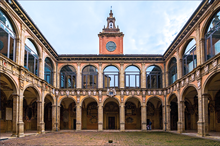
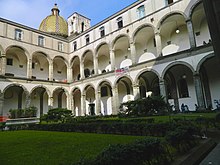
The oldest known institutions of higher education are credited to Dynastic Egypt, with Pr-Anx (houses of life) built as libraries and scriptoriums, containing works on law, architecture, mathematics, and medicine, and involved in the training of "swnw" and "swnwt" (male and femaledoctors); extantEgyptian papyrifrom the 3rd millennia BC are in several collections.[22]
In the Greek world,Plato's Academy(c. 387- 86 BC),Aristotle's Lyceum(c. 334- 86 BC) and other philosophical-mathematical schools became models for other establishments, particularly inAlexandriaof Egypt, under thePtolemies.
InSouth Asia,the city ofTaxila[when?],later the great Buddhist monastery ofNalanda(c. 427- 1197 CE), attracted students and professors even from distant regions.[23]
InChina,theHan dynastyestablished chairs to teach theFive Confucean Classics,in the Grand School,Taixue(c. 3- 1905CE), to train cadres for the imperial administration.[24][25]All these higher-learning institutions became models for other schools within their sphere of cultural influence.[26]
In 425 CE, the Byzantine emperorTheodosius IIinnovated as he established thePandidakterion,with a faculty of 31 professors, to train public servants. In the 7th and 8th centuries, "cathedral schools" were created in Western Europe. Meanwhile, the first Medresahs were founded in the Moslem empire – initially mere primary schools in the premises of major mosques, which gradually evolved toward secondary, later higher education. However high the intellectual level of these schools could be, it would be anachronistic to call them "universities". Their organization and purposes were markedly different from the corporations of students and teachers, independent from both the Church and the State, which established themselves from the 12th century in Western Europe asUniversitas Studiorum.[citation needed]
According toUNESCOandGuinness World Records,theUniversity of al-QarawiyyininFez, Moroccois theoldest existing continually operatinghigher educational institution in the world.[27][28]and is occasionally referred to as the oldest university by scholars.[29]Undoubtedly, there are older institutions of higher education, for example, theUniversity of Ez-Zitounain Montfleury,Tunis,was first established in 737. TheUniversity of Bologna,Italy, founded in 1088, is the world's oldest university in continuous operation,[30][31][32][33][34]and the first university in the sense of a higher-learning and degree-awarding institute, as the worduniversitaswas coined at its foundation.[33][30][31][32]
20th century[edit]
SinceWorld War II,developed and many developing countries have increased the participation of the age group who mostly studies higher education from the elite rate, of up to 15 per cent, to the mass rate of 16 to 50 per cent.[35][36]In many developed countries, participation in higher education has continued to increase towards universal or, what Trow later called, open access, where over half of the relevant age group participate in higher education.[37]Higher education is important to nationaleconomies,both as an industry, in its own right, and as a source of trained and educated personnel for the rest of the economy. College educated workers have commanded a measurable wage premium and are much less likely to become unemployed than less educated workers.[38][39]
21st century[edit]
In recent years, universities have been criticized for permitting or actively encouraginggrade inflation.[40][41] Widening participationcan increase the supply of graduates in individual fields of study over the demand for their skills, aggravatinggraduate unemployment,underemployment,overqualificationandeducational inflation.[42][43]Some commentators have suggested that theimpact of the COVID-19 pandemic on educationis rapidly making certain aspects of the traditional higher education system obsolete.[44]The involvement and funding by foreign regimes inhigher education in the USand Europe raised concerns regarding the erosion of democratic norms and hate speech on campuses.[45][better source needed][46]
Statistics[edit]
The total expenditure on tertiary education (ISCEDlevels 5 to 8) as a percentage of GDP for individual countries is shown in the following table.
| Country | Tertiary Education expenditure as % of GDP 2020[47] |
|---|---|
| 1.9 | |
| 1.8 | |
| 1.6 | |
| 1.2 | |
| 2.4 | |
| 2.7 | |
| 1.5 | |
| 1.6 | |
| 1.2 | |
| 1.1 | |
| 1.9 | |
| 1.5 | |
| 1.6 | |
| 1.6 | |
| 1.3 | |
| 0.9 | |
| 0.9 | |
| 1.4 | |
| 0.8 | |
| 1.4 | |
| 1.0 | |
| 1.4 | |
| 1.4 | |
| 1.2 | |
| 0.5 | |
| 1.2 | |
| 1.8 | |
| 1.6 | |
| 2.0 | |
| 1.3 | |
| 1.3 | |
| 0.8 | |
| 1.1 | |
| 1.2 | |
| 1.5 | |
| 1.5 | |
| 1.6 | |
| 1.5 | |
| 1.5 | |
| 2.5 |
The percentage of adults who have attained individual tertiary education levels by country is shown in the following table.
| Country | Ages 25–64: % attaining a tertiary degree course equivalent to at least:[48] | |||
|---|---|---|---|---|
| Any tertiary | Bachelor's | Master's | Doctoral | |
| 24.8 | 1.4 | |||
| 51.5 | 39.4 | 10.9 | 1.9 | |
| 35.6 | 20.4 | 14.8 | 1.2 | |
| 45.8 | 45.0 | 20.1 | 1.1 | |
| 21.0 | 21.0 | 1.0 | 0.3 | |
| 29.8 | 29.8 | 20.4 | 0.3 | |
| 62.7 | ||||
| 31.4 | ||||
| 18.5 | ||||
| 28.3 | ||||
| 25.3 | ||||
| 26.7 | 26.5 | 19.7 | 0.7 | |
| 42.1 | 37.0 | 16.3 | 1.5 | |
| 42.1 | 36.5 | 21.8 | 0.8 | |
| 42.6 | 35.1 | 17.3 | 1.3 | |
| 41.6 | 27.2 | 15.2 | 1.0 | |
| 32.5 | 31.9 | 13.6 | 1.9 | |
| 35.1 | 34.7 | 9.3 | 0.9 | |
| 29.4 | 28.5 | 13.9 | 0.5 | |
| 12.9 | 12.9 | 3.4 | 3.4 | |
| 13.1 | 10.3 | 0.8 | 0.0 | |
| 43.6 | 39.4 | 18.1 | 1.2 | |
| 54.4 | 44.3 | 16.6 | 1.7 | |
| 50.6 | 39.6 | 15.2 | 1.2 | |
| 20.3 | 20.2 | 14.6 | 0.6 | |
| 56.1 | ||||
| 39.5 | 35.1 | 18.4 | 0.4 | |
| 46.5 | 46.5 | 16.5 | 0.8 | |
| 51.5 | 46.6 | 31.4 | 2.9 | |
| 20.6 | 20.1 | 1.9 | 0.1 | |
| 44.7 | 42.4 | 18.2 | 1.2 | |
| 39.8 | 35.8 | 6.3 | 1.1 | |
| 48.1 | 36.5 | 15.4 | 1.5 | |
| 33.9 | 33.8 | 26.2 | 0.8 | |
| 31.5 | 31.2 | 21.7 | 0.9 | |
| 19.7 | ||||
| 29.2 | 29.1 | 25.3 | 0.9 | |
| 40.1 | 31.7 | 20.1 | 3.7 | |
| 52.8 | ||||
| 13.9 | ||||
| 41.1 | 28.5 | 17.2 | 0.8 | |
| 48.5 | 38.7 | 18.7 | 2.0 | |
| 44.7 | 44.7 | 20.0 | 3.2 | |
| 25.0 | 18.3 | 2.3 | 0.4 | |
| 51.3 | 42.3 | 15.8 | 1.7 | |
| 50.0 | 39.4 | 14.4 | 2.1 | |
A 2014 report by theOrganisation for Economic Co-operation and Developmentstates that by 2014, 84 percent of young people were completing upper secondary education over their lifetimes, in high-income countries. Tertiary-educated individuals were earning twice as much as median workers. In contrast to historical trends in education, young women were more likely to complete upper secondary education than young men. Additionally, access to education was expanding and growth in the number of people receiving university education was rising sharply. By 2014, close to 40 percent of people aged 25–34 (and around 25 percent of those aged 55–64), were being educated at university.[49]
United Kingdom[edit]
Underdevolution in the United Kingdom,education is administered separately in England, Wales, Northern Ireland, and Scotland. In England, the term "tertiary education" aligns with the global term "higher education"(i.e. post-18 study).[50]In 2018 the Welsh Government adopted the term "tertiary education" to refer to post-16 education and training in Wales.[51]Since the 1970s, however, specializedfurther education collegesin England and Wales have called themselves "tertiary colleges"although being part of thesecondary educationprocess. These institutions cater for both school leavers and adults, thus combining the main functions of an FE college and asixth form college.[52]Generally, district councils with such colleges have adopted a tertiary system or structure where a single local institution provides all the 16–19 and adult education, and where schools do not universally offer sixth forms (i.e. schools only serve ages 11–16). However theFurther and Higher Education Act 1992has effectively prevented the creation of new tertiary colleges.[53]
Australia[edit]

Within Australia "tertiary education" refers to continuing studies after a student completes secondary school. Tertiary education options include universities,technical and further education(TAFE) or private universities.[54]
United States[edit]

Thehigher education system in the United Statesis decentralized and regulated independently by each state[55]withaccreditorsplaying a key role in ensuring institutions meet minimum standards. It is large and diverse with institutions that are privately governed and institutions that are owned and operated by state and local governments. Some private institutions are affiliated with religious organizations whereas others are secular with enrollment ranging from a few dozen to tens of thousands of students. The United States Department of Education presents a broad-spectrum view of tertiary education and detailed information on the nation's educational structure, accreditation procedures, and connections to state as well as federal agencies and entities.[56]
TheCarnegie Classification of Institutions of Higher Educationprovides one framework for classifying U.S. colleges and universities in several different ways.[57]US tertiary education also includes various non-profit organizations promoting professional development of individuals in the field of higher education and helping expand awareness of related issues like international student services and complete campus internationalization.[58][59]
European Union[edit]
Although tertiary education in theEUincludes university, it can differ from country to country.
France[edit]
After going tonursery school(French: école maternelle),elementary school(French: école élémentaire),middle school(French: collège), andhigh school(French: lycée), a student may go to university, but may also stop at that point.
Italy[edit]

Education in Italyis compulsory from 6 to 16 years of age,[62]and is divided into five stages: kindergarten (scuola dell'infanzia), primary school (scuola primariaorscuola elementare),lower secondary school(scuola secondaria di primo gradoorscuola media inferiore),upper secondary school(scuola secondaria di secondo gradoorscuola media superiore) and university (università).[63]Education is free in Italy and free education is available to children of all nationalities who are residents in Italy. Italy has both a private and public education system.[64]
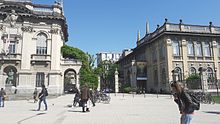

Italy has a large and international network of public or state-affiliated universities and schools offering degrees in higher education. State-run universities of Italy constitute the main percentage of tertiary education in Italy and are managed under the supervision of Italian's Ministry of Education.
Italian universities are among the oldest universities in the world; theUniversity of Bologna(founded in 1088) notably, isthe oldest one ever;also,University of Naples Federico IIare is the world's oldest state-funded university in continuous operation.[67][68]Most universities in Italy are state-supported. 33 Italian universities were ranked among the world's top 500 in 2019, the third-largest number in Europe after the United Kingdom and Germany.[69]
There are also a number ofSuperior Graduate Schools(Grandes écoles)[70]orScuola Superiore Universitaria,offer officially recognized titles, including theDiploma di Perfezionamentoequivalent to a Doctorate,Dottorato di Ricercai.e.Research DoctorateorDoctor Philosophiaei.e. PhD.[71]Some of them also organize courses Master's degree. There are three Superior Graduate Schools with "university status", three institutes with the status of Doctoral Colleges, which function atgraduateand post-graduate level. Nine further schools are direct offshoots of the universities (i.e. do not have their own 'university status'). The first one is theScuola Normale Superiore di Pisa(founded in 1810 byNapoleonas a branch ofÉcole Normale Supérieure), taking the model of organization from the famousÉcole Normale Supérieure.These institutions are commonly referred to as "Schools of Excellence" (i.e. "Scuole di Eccellenza" ).[70][72]
Italy hosts a broad variety of universities, colleges and academies. Founded in 1088, theUniversity of Bolognais likelythe oldest in the world.[73]In 2009, the University of Bologna is, according toThe Times,the only Italian college in the top 200 World Universities. Milan'sBocconi Universityhas been ranked among the top 20 best business schools in the world byThe Wall Street Journalinternational rankings, especially thanks to itsM.B.A.program, which in 2007 placed it no. 17 in the world in terms of graduate recruitment preference by major multinational companies.[74]Bocconi was also ranked byForbesas the best worldwide in the specific category Value for Money.[75]In May 2008, Bocconi overtook several traditionally top global business schools in theFinancial TimesExecutive educationranking, reaching no. 5 in Europe and no. 15 in the world.[76]
Other top universities and polytechnics are theUniversità Cattolica del Sacro Cuorein Milan, theLUISSin Rome, thePolytechnic University of Turin,thePolitecnico di Milano(which in 2011 was ranked as the 48th best technical university in the world byQS World University Rankings[77]), theUniversity of Rome La Sapienza(which in 2005 was Europe's 33rd best university,[78]and ranks among Europe's 50 and the world's 150 best colleges[79]and in 2013, the Center for World University Rankings ranked theSapienza University of Rome62nd in the world and the top in Italy in itsWorld University Rankings.[80]) and theUniversity of Milan(whose research and teaching activities have developed over the years and have received important international recognition). This University is the only Italian member of the League of European Research Universities (LERU), a prestigious group of twenty research-intensive European Universities. It has also been awarded ranking positions such as 1st in Italy and 7th in Europe (TheLeiden Ranking– Universiteit Leiden).
Africa[edit]
Nigeria[edit]

Tertiary education refers to post-secondary education received at universities (government or privately funded), monotechnics, polytechnics and colleges of education. After completing a secondary education, students may enroll in a tertiary institution or acquire avocational education.Students are required to sit for theJoint Admissions and Matriculation BoardEntrance Examination (JAMB) as well as theSecondary School Certificate Examination(SSCE) or General Certificate Examination (GCE) and meet varying cut-off marks to gain admission into a tertiary institution.[81]
Asia[edit]
Japan[edit]

According to MEXT (Ministry of Education) and UNESCO, following types of education are classified as tertiary education: University education (undergraduate, postgraduate and professional degrees), two-year colleges (Tanki Daigaku), colleges of technology and specialised colleges.[82]
Hong Kong[edit]
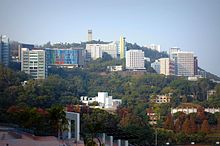
In Hong Kong "tertiary education" or "higher education" refers to any education higher than secondary education. Tertiary education includes universities, post secondary colleges, statutory universities, and publicly funded institutions.
See also[edit]
- Category:Higher education by country
- List of countries by tertiary education attainment
- Education by country
- List of higher education associations and alliances
- List of universities and colleges by country
- Student SPILL
- College and university rankings
- Governance in higher education
- Graduation
- Higher education accreditation
- Higher education bubble
- Higher education policy
- Higher Education Price Index
- Institute
- UnCollege
- Hochschule
- League of European Research Universities
- Technical and Further Education(TAFE)
Higher education by country[edit]
- Tertiary education in Australia
- Higher education in Canada
- Higher education in Ukraine
- Universities in the United Kingdom
- Higher education in the United States
- Higher education in the Philippines
- Higher education in Portugal
Notes[edit]
- ^For example,Higher Education: General and Technical,a 1933National Union of Teacherspamphlet byLord Eustace Percy,which is actually about secondary education and uses the two terms interchangeably.
References[edit]
- ^"Tertiary Education".World Bank.Archivedfrom the original on 10 December 2017.Retrieved9 December2017.
- ^"Tertiary education (ISCED levels 5 to 8)".uis.unesco.org.Archived fromthe originalon 8 February 2020.Retrieved2 July2018.
- ^"World Bank World Development Report 2019: The Changing Nature of Work"(PDF).Archived(PDF)from the original on 6 September 2019.Retrieved12 October2018.
- ^Revision of the International Standard Classification of Education (ISCED)Archived2017-05-25 at theWayback Machine,Retrieved 5 April 2012.
- ^"high school".Cambridge Dictionary.Archivedfrom the original on 27 February 2021.Retrieved24 June2021.
- ^abcd#CommitToEducation.UNESCO. 2019.ISBN978-92-3-100336-3.Archivedfrom the original on 11 February 2020.Retrieved7 February2020.
- ^.1966 – viaWikisource.
- ^"Protocol No. 1 to the Convention - Toolkit".Council of Europe.Archivedfrom the original on 27 March 2023.Retrieved27 March2023.
- ^Thompson, Stephen (2020),"Developing disability-inclusive higher education systems"(PDF),International Higher Education,no. 100,archived(PDF)from the original on 13 June 2022,retrieved22 April2022
- ^Gunn, Andrew; Kapade, Priya (25 May 2018),The university grade inflation debate is going global,University World News,archivedfrom the original on 26 May 2018,retrieved23 June2019,
The grading process has been compromised as universities are incentivised to meet the demands of their customers and graduate more students with top grades to boost their institutional ranking.
- ^Baker, Simon (28 June 2018)."Is grade inflation a worldwide trend?".The World University Rankings.Times Higher Education.Archivedfrom the original on 25 October 2019.Retrieved23 June2019.
Departments where enrollments were falling felt under pressure to relax their grading practices to make their courses more attractive, leading to an "arms race" in grade inflation.
- ^Coates, Ken; Morrison, Bill (2016),Dream Factories: Why Universities Won't Solve the Youth Jobs Crisis,Toronto: Dundurn Books, p. 232,ISBN9781459733770,archived fromthe originalon 1 June 2016,retrieved18 July2020
- ^Brown, Phillip; Lauder, Hugh; Ashton, David (2012),"The Global Auction: The Broken Promises of Education, Jobs, and Incomes",International Review of Education,57(5–6), Oxford University Press: 208,Bibcode:2011IREdu..57..785A,doi:10.1007/s11159-011-9242-8,ISBN9780199926442,S2CID153328528
- ^Ford, Robert; Jennings, Will (2020)."The Changing Cleavage Politics of Western Europe".Annual Review of Political Science.23:295–314.doi:10.1146/annurev-polisci-052217-104957.
- ^"The Difference Between Continuing Education and Professional Development".Columbia Southern University.1 April 2021. Archived fromthe originalon 17 October 2021.Retrieved17 October2021.
- ^"6 Reasons Why Continuing Education Is Important".Western Governors University.26 April 2019.Archivedfrom the original on 17 October 2021.Retrieved17 October2021.
- ^Pucciarelli F., Kaplan Andreas M. (2016)Competition and Strategy in Higher Education: Managing Complexity and UncertaintyArchived2019-01-10 at theWayback Machine,Business Horizons, Volume 59
- ^Jenkins, Anne (20 January 2015)."Employers Judge Recent Graduates Ill-Prepared for Today's Workplace, Endorse Broad and Project-Based Learning as Best Preparation for Career Opportunity and Long-Term Success"(Press release). Washington, DC:Association of American Colleges and Universities.Archived fromthe originalon 12 April 2017.Retrieved11 April2017.
- ^"Lisbon Recognition Convention".coe.int.Archivedfrom the original on 28 May 2019.Retrieved28 May2019.
- ^Storia d'Italia.Vol. 4. Torino: UTET. 7 August 1981. p. 122.ISBN88-02-03568-7.
- ^Delle Donne, Fulvio (2010).Storia dello Studium di Napoli in età sveva(in Italian). Mario Adda Editore. pp. 9–10.ISBN978-8880828419.
- ^Gordan, Andrew H.; Shwabe, Calvin W. (2004).The Quick and the Dead: Biomedical Theory in Ancient Egypt.Egyptological Memoirs.Leiden:Brill Academic Publishers.p. 154.ISBN978-90-04-12391-5.
- ^Mookerji, Radha Kumud (1989) [1947].Ancient Indian education: Brahmanical and Buddhist.History and Culture Series (2nd ed.). Delhi:Motilal Banarsidass.ISBN978-81-208-0423-4.
- ^Balazs, Étienne (1968).La Bureaucratie céleste: recherches sur l'économie et la société de la Chine traditionnelle.Bibliothèque des sciences humaines (in French). Paris: Gallimard.
- ^Peter Tze Ming Ng (2001), "Paradigm shift and the state of the field in the study of Christian higher education in China",Cahiers d’Extrême-Asie,no. 12, pp. 127–140
- ^Yang, Rui (2 September 2019)."Emulating or integrating? Modern transformations of Chinese higher education".Journal of Asian Public Policy.12(3): 294–311.doi:10.1080/17516234.2018.1448213.ISSN1751-6234.
- ^"Oldest higher-learning institution, oldest university".Guinness World Records.Archivedfrom the original on 7 October 2014.Retrieved24 June2021.
- ^"Medina of Fez".UNESCO World Heritage Centre.UNESCO.Archivedfrom the original on 19 September 2017.Retrieved7 April2016.
- ^Verger, Jacques: "Patterns", in: Ridder-Symoens, Hilde de (ed.):A History of the University in Europe. Vol. I: Universities in the Middle Ages,Cambridge University Press, 2003,ISBN978-0-521-54113-8,pp. 35–76 (35)
- ^ab"Times Higher Education - QS World University Rankings 2007 - World's oldest universities".QS Top Universities.Archived fromthe originalon 17 January 2009.Retrieved6 January2010.
- ^abGaston, Paul L. (2010).The challenge of Bologna: What United States higher education has to learn from Europe, and why it matters that we learn it.Sterling, Virginia: Stylus Publishing. p. 18.ISBN978-1-57922-366-3.OCLC320189904.
- ^abJanin, Hunt (2008).The University in Medieval Life, 1179-1499.Jefferson, NC: McFarland. pp. 55f.ISBN978-0-7864-3462-6.
- ^abde Ridder-Symoens, Hilde:A History of the University in Europe: Volume 1, Universities in the Middle AgesArchived2022-11-24 at theWayback Machine,Cambridge University Press, 1992,ISBN0-521-36105-2,pp. 47–55
- ^"The Porticoes of Bologna".UNESCO Centre du patrimoine mondial(in French). Archived fromthe originalon 15 August 2020.Retrieved16 August2020.
- ^Trow, Martin (1973).Problems in the transition from elite to mass higher education(PDF)(Report). Berkeley: Carnegie Commission on Higher Education.Retrieved1 August2013.
- ^Brennan, John (2002)."The social role of the contemporary university: contradictions, boundaries and change"(PDF).Ten years on: Changing higher education in a changing world.Buckingham: Centre for Higher Education Research and Information, Open University. pp. 22–26. Archived fromthe original(PDF)on 25 May 2017.Retrieved9 February2014.
- ^Trow, Martin (5 August 2005),Reflections on the transition from elite to mass to universal access: forms and phases of higher education in modern societies since WWIIRepublished inForest, James J. F.; Altbach, Philip G., eds. (20 April 2006).International Handbook of Higher Education: Part One: Global Themes and Contemporary Challenges.Springer International Handbooks of Education. Vol. 18. Dordrecht, Netherlands: Springer. pp. 243–280.ISBN978-1-4020-4011-5.OCLC65166668.
- ^Simkovic, Michael (5 September 2011). "Risk-Based Student Loans".Washington and Lee Law Review.SSRN1941070.
- ^OECD (2011),Education at a Glance
- ^Gunn, Andrew; Kapade, Priya (25 May 2018),"The university grade inflation debate is going global",University World News,archivedfrom the original on 26 May 2018,retrieved23 June2019,
The grading process has been compromised as universities are incentivised to meet the demands of their customers and graduate more students with top grades to boost their institutional ranking.
- ^Baker, Simon (28 June 2018),"Is grade inflation a worldwide trend?",The World University Rankings,Times Higher Education,archivedfrom the original on 25 October 2019,retrieved23 June2019,
Departments where enrollments were falling felt under pressure to relax their grading practices to make their courses more attractive, leading to an "arms race" in grade inflation.
- ^Coates, Ken; Morrison, Bill (2016),Dream Factories: Why Universities Won't Solve the Youth Jobs Crisis,Toronto: Dundurn Books, p. 232,ISBN9781459733770,archivedfrom the original on 21 September 2021,retrieved21 September2021
- ^Brown, Phillip; Lauder, Hugh; Ashton, David (2012),The Global Auction: The Broken Promises of Education, Jobs, and Incomes,Oxford University Press, p. 208,ISBN9780199926442,archivedfrom the original on 10 March 2021,retrieved11 December2020
- ^Kaplan, Andreas (6 April 2021).Higher education at the crossroads of disruption: The university of the 21st century.Emerald.doi:10.1108/9781800715011.ISBN978-1-80071-504-2.S2CID233594353.
- ^"Follow the Money: Qatar Funding of Higher Education".Institute for the Study of Global Antisemitism and Policy.Retrieved24 December2023.
- ^Shulman, Sophie (30 October 2023)."Tuition of terror: Qatari money flowed into U.S. universities - and now it's fueling violence".CTech.Rishon LeZion, Israel: Yedioth Ahronoth Group.Retrieved30 April2024.
- ^OECD.stat Educational Finance Indicators Indicator C2: Total expenditure on educational institutions as a percentage of GDP, 2020
- ^OECD.stat Educational attainment and labour-force status, Educational attainment of 2-64 year-olds, 2022
- ^Organisation for Economic Co-operation and Development(September 2014)."Higher levels of education paying off for young, says OECD".Archived fromthe originalon 28 June 2013.Retrieved11 September2014.
- ^"Independent panel report to the Review of Post-18 Education and Funding"(PDF).May 2019.Archived(PDF)from the original on 10 December 2020.Retrieved3 March2022.
- ^"Welsh Government | Written Statement - Public Good and a Prosperous Wales – Next steps".gov.wales.Archivedfrom the original on 12 June 2018.Retrieved7 June2018.
- ^"Public Expenditure on Education and Skills: Second Report of Session 2005–06"(PDF).House of Commons Education and Skills Committee. 2006.Archived(PDF)from the original on 4 December 2021.Retrieved22 April2022.
- ^"White Paper: Education and Training for the 21st century (1991)".Archived fromthe originalon 2 October 2021.Retrieved2 October2021.
- ^"Education and Work, Australia, May 2022 | Australian Bureau of Statistics".abs.gov.au.11 October 2022.Archivedfrom the original on 31 March 2023.Retrieved23 May2023.
- ^"For Profit Postsecondary Schools: Oversight and Governing Statutes & Regulations"(PDF).caichildlaw.org.2014.Archived(PDF)from the original on 15 May 2022.Retrieved22 April2022.
- ^"National Center for Education Statistics (NCES) Home Page, part of the U.S. Department of Education".nces.ed.gov.Retrieved2 July2018.
- ^"IU research Center to House Carnegie Classification of Institutions of Higher Education | Carnegie Foundation for the Advancement of Teaching".Carnegie Foundation for the Advancement of Teaching.7 October 2014.Archivedfrom the original on 22 December 2017.Retrieved2 July2018.
- ^"Understanding U.S. Higher Education".EducationUSA.8 January 2015.Archivedfrom the original on 2 July 2018.Retrieved2 July2018.
- ^"The American Council on Education".acenet.edu.Archivedfrom the original on 2 July 2018.Retrieved2 July2018.
- ^"La Storia".
- ^"Chi Siamo".
- ^"comma 622".Camera.it. 2 December 2006.Retrieved10 January2018.
- ^"- Human Development Reports"(PDF).hdr.undp.org.
- ^Bertola, Giuseppe; Checchi, Daniele; Oppedisano, Veruska (December 2007)."Private School Quality in Italy"(PDF).Discussion Paper Series(IZA DP No. 3222).IZA Institute of Labor Economics.
- ^"QS World University Rankings 2018".QS World University Rankings.Retrieved9 October2017.
- ^"Global MBA Ranking 2017".Rankings.ft.Archivedfrom the original on 4 December 2017.Retrieved10 February2017.
- ^Storia d'Italia(in Italian). Vol. 4. Torino: UTET. 7 August 1981. p. 122.ISBN88-02-03568-7.
- ^Delle Donne, Fulvio (2010).Storia dello Studium di Napoli in età sveva(in Italian). Mario Adda Editore. pp. 9–10.ISBN978-8880828419.
- ^"Number of top-ranked universities by country in Europe".jakubmarian. 2019.
- ^ab"Pagina di transizione".ricercaitaliana.it.
- ^"SITO IN MANUTENZIONE".istruzione.it.
- ^"Scuole – Scuole di Eccellenza".scuoledieccellenza.it.
- ^"Università di Bologna (oldest university in the world)".Virtual Globetrotting. 21 October 2006.Retrieved27 October2009.
- ^"Conferenze, ospiti, news ed eventi legati agli MBA della SDA Bocconi – MBA SDA Bocconi".SDA Bocconi. Archived fromthe originalon 27 June 2008.Retrieved30 October2010.
- ^"Gatech:: OIE:: GT Study Abroad Programs".Archived fromthe originalon 8 May 2008.Retrieved30 October2010.
- ^"Sda Bocconi supera London Business School – ViviMilano".Corriere della Sera.12 November 2008. Archived fromthe originalon 24 September 2008.Retrieved30 October2010.
- ^"Politecnico di Milano – QS World University Rankings".topuniversities.Retrieved8 February2012.
- ^"Top 100 European Universities".Arwu.org. Archived fromthe originalon 30 April 2008.Retrieved27 October2009.
- ^"ARWU2008".Arwu.org. Archived fromthe originalon 22 August 2008.Retrieved27 October2009.
- ^"World University Rankings 2013".Center for World University Rankings. 2013.Retrieved17 July2013.
- ^"6 requirements you MUST meet to gain admission into higher institutions".Pulse Nigeria.17 January 2018.Archivedfrom the original on 17 December 2019.Retrieved17 December2019.
- ^"DATA MAPPING – ISCED".Retrieved11 April2024.
Sources[edit]
- Brick, Jean (2006). "What is academic culture?".Academic Culture: A Student's Guide to Studying at University.Sydney, NSW: National Centre for English Language Teaching and Research. pp. 1–10.ISBN978-1-74138-135-1.
 This article incorporates text from afree contentwork. Licensed under CC BY-SA 3.0 IGO. Text taken from#CommitToEducation,35, UNESCO, UNESCO. UNESCO.
This article incorporates text from afree contentwork. Licensed under CC BY-SA 3.0 IGO. Text taken from#CommitToEducation,35, UNESCO, UNESCO. UNESCO.
Further reading[edit]
- Alkamel, Mohammed Adulkareem A.; Chouthaiwale, Santosh S.; Yassin, Amr Abdullatif; AlAjmi, Qasim; Albaadany, Hanan Yahia (March 2021). "Online Testing in Higher Education Institutions During the Outbreak of COVID-19: Challenges and Opportunities". In Arpaci, Ibrahim; Al-Emran, Mostafa; Al-Sharafi, Mohammed A.; Marques, Gonçalo (eds.).Emerging Technologies During the Era of COVID-19 Pandemic.Studies in Systems, Decision and Control. Vol. 348.Cham, Switzerland:Springer Nature.pp. 349–363.doi:10.1007/978-3-030-67716-9_22.ISBN978-3-030-67715-2.PMC7980164.S2CID232322223.
- Council of Europe Higher Education Series
